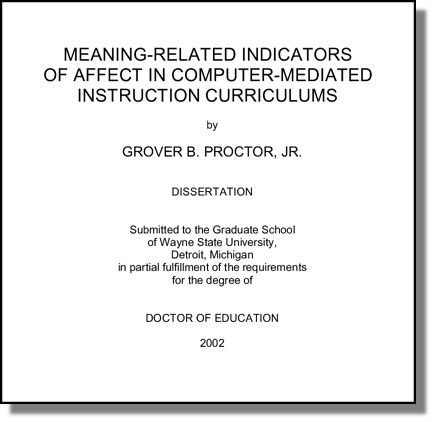


|
The increasing use of computer-mediated instruction in recent years has spawned a revolution in learning and has caused educational practitioners to measure this new mode of learning against the theoretical underpinnings of traditional classroom education. This study specifically looked to find evidence of behaviorally based affective components inside computer-mediated instructional (CMI) experiences, as a first step to determining if the affective domain can exist anywhere there is not a live human teacher present. In education, the affective domain comprises those elements in which students are encouraged to form valuative, emotional, attitudinal, aesthetic, and/or integrational judgments about the cognitive learning processes undertaken. Previous CMI studies involving the affective component centered mainly on gender-related issues and on computer anxiety and self-efficacy, and so individual gender and anxiety scales were added to reflect these issues. The study used the Semantic Differential inventory tool to examine students' perceptions through their meaning-derived reactions to a series of twelve behaviorally based activities, chosen to represent (1) computer-mediated learning, (2) traditional classroom activities, (3) affectively laden activities, and (4) non-classroom uses of computers. Multidimensional scaling (MDS) produced two-dimensional mappings of students' meaning-derived perceptions of these activities. The study found evidence that CMI is least associated with the affective activities, that it is also dissociated with oral portions of traditional classroom learning (e.g., giving an oral report, class discussion, and classroom lectures), and that it is most closely associated with written aspects of the traditional classroom (e.g., taking an exam or writing a paper). Non-classroom uses of computers (e.g., use of e-mail, use of Internet) seem to be dissociated with all of the above. Both MDS mappings and ANOVA demonstrated no gender-related differences in any of these perceptions except on the individual Gender scale. On the Anxiety scale, participants showed low levels of correlation between CMI and affective activities, but high correlation between CMI and both traditional classroom activities and non-classroom uses of computers. In sum, not only were gender differences on computer usage debunked, but the study’s findings of the wide gap in students’ mappings of affect and CMI provides new evidence that curricularists wishing to integrate affective domain into CMI have challenges in bringing the two concepts together--if in fact that is possible in a learning environment where there is no live human teacher.
|
|

